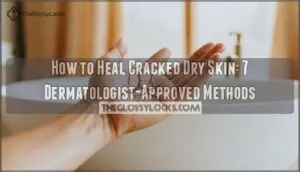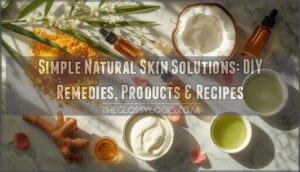This site is supported by our readers. We may earn a commission, at no cost to you, if you purchase through links.

Here’s what actually works: grab a ceramide moisturizer and slather it on within three minutes of your shower, while your skin’s still damp. That timing makes all the difference—way better than slapping expensive cream on completely dry skin.
Stick to lukewarm water when you wash and skip the harsh soaps that strip your skin even more.
What you eat matters more than most people realize—getting enough protein and vitamin D actually helps your skin rebuild itself.
The real win comes from tackling this two ways: fix the immediate damage while also changing the habits that caused it in the first place.
Table Of Contents
Key Takeaways
- Apply ceramide-rich moisturizers within three minutes of bathing while skin is still damp to lock in moisture and rebuild your skin’s protective barrier more effectively than expensive creams on dry skin.
- Use gentle cleansing with lukewarm water and avoid harsh soaps to prevent further damage to your already compromised skin barrier.
- Address nutritional deficiencies by ensuring adequate protein and vitamin D intake, as these nutrients aid the healing process from within and support tissue repair.
- Control environmental factors like humidity levels between 30-50% using humidifiers and protect skin with breathable fabrics to prevent moisture loss and irritation.
What Causes Cracked Dry Skin?
Understanding what triggers cracked dry skin is your first step toward breaking free from this uncomfortable cycle.
Environmental factors like cold weather and low humidity work alongside underlying conditions such as eczema, diabetes, and nutritional deficiencies to compromise your skin’s natural protective barrier.
Environmental Triggers (Weather, Humidity)
Think your skin can handle whatever Mother Nature throws at it? Winter’s dry air and summer’s scorching heat can turn your skin’s protective barrier into something that feels more like cracked pavement than a healthy defense system. Climate change and seasonal swings create the perfect storm for skin dryness.
Here are 5 environmental triggers that wreck your skin’s hydration:
- Cold weather – strips natural oils faster than you can replace them
- Low humidity below 30% – pulls moisture straight from your skin
- Indoor heating – creates desert-like conditions year-round
- Air conditioning – removes humidity while you sleep
- Wind exposure – speeds up moisture loss through evaporation
That’s where humidity control comes in. It’s one of your best defenses against all these moisture-stealing culprits.
Underlying Health Conditions (Eczema, Psoriasis, Diabetes)
Your body’s internal battles can wreak havoc on your skin barrier. Eczema, affecting 31.6 million Americans, creates chronic inflammation that weakens skin defenses and triggers painful fissures. Psoriasis, an autoimmune disorder impacting over 40 million people worldwide, generates thick, scaly patches that crack easily. Diabetes presents unique challenges—poor circulation and high blood sugar levels literally pull moisture from your skin cells, while diabetic neuropathy reduces your ability to feel developing cracks before they become infected. Understanding the impact of blood sugar management is vital for preventing skin complications.
| Condition | Key Impact on Skin |
|---|---|
| Eczema | Compromised barrier function, chronic inflammation |
| Psoriasis | Rapid cell turnover, thick scaly plaques |
| Diabetes | Reduced circulation, moisture depletion |
| Autoimmune Disorders | Systemic inflammation, delayed healing |
| Skin Infections | Secondary bacterial/fungal complications |
Lifestyle and Hygiene Factors
Your daily habits might be working against your skin without you realizing it. A few tweaks to how you care for your skin can make a huge difference with dryness.
- Those long, hot showers? They’re washing away your skin’s natural oils
- Harsh soaps mess with the protective barrier your skin relies on
- Washing too much strips away moisture your skin actually needs
- Skip the daily moisturizer and your skin gets prone to cracking
- Synthetic fabrics can bug skin that’s already having a rough time
When you’re gentle with cleansing and make some smart lifestyle tweaks, your skin gets a real chance to bounce back.
Nutritional Deficiencies Affecting Skin Health
While most people blame weather or genetics for their cracked skin, hidden nutritional gaps might be sabotaging your skin’s natural healing power from the inside out.
Vitamin D deficiency weakens your skin barrier, while inadequate protein intake slows wound healing and tissue repair.
Low calorie consumption starves cells of energy needed for regeneration, and poor nutrient absorption prevents essential minerals like zinc from reaching damaged skin areas.
How Does Nutrition Support Skin Healing?
Think of your skin like a construction site that never stops working. It’s constantly tearing down old, damaged cells and building fresh ones to replace them.
Your skin operates like a construction site that never stops working, constantly breaking down old cells and building fresh replacements
But here’s the thing—it can only work with the materials you give it.
When you fuel your body with adequate calories, protein, vitamins, and minerals, you’re giving your skin the essential building blocks it needs to heal faster and stronger.
Role of Calories and Protein in Recovery
Think of calories and protein as the building blocks your skin desperately needs to patch itself back together after damage. Without adequate calorie intake, your body can’t fuel the energy-intensive wound healing process.
Protein supplements or dietary protein provide essential amino acids that create new skin cells and repair damaged tissue. This nutrient balance directly impacts your energy levels and recovery speed.
Importance of Vitamins and Minerals (A, C, D, E, Zinc)
Breaking down the science reveals how specific vitamins and minerals directly impact your skin’s ability to heal and maintain its protective barrier. Vitamin A deficiency accounts for 25% of dry skin cases in children, while vitamin C deficiency appears in 75% of people with chronic wounds. Your skin stores about 6% of your body’s total zinc, with deficiencies linked to 40% of childhood eczema cases.
These nutrients work as powerful skin antioxidants and assist nutrient absorption for peak healing. Understanding the role of vitamin A benefits is vital for developing effective skin care routines.
Managing Blood Sugar for Optimal Skin Health
Your blood sugar levels can make or break your skin’s healing journey, especially when diabetes turns your body into a battleground where wounds struggle to close.
High glucose triggers skin glycation, damaging collagen and slowing repair. Insulin resistance creates inflammation that worsens dry skin and irritation.
Maintaining stable blood sugar through diabetes management and nutrient balance gives your skin the fighting chance it needs.
Staying Hydrated for Skin Healing
Water isn’t just something you drink—it’s the foundation your skin cells need to rebuild and repair themselves from the inside out. When you maintain proper fluid intake, you’re aiding your skin barrier’s natural moisture balance and creating ideal conditions for healing.
- Target 8-10 glasses daily to maintain adequate electrolyte levels
- Choose water-rich foods like cucumber and watermelon for hydration therapy
- Monitor your skin water content by checking elasticity on your hand
- Balance fluid intake with minerals to aid cellular repair processes
- Apply hyaluronic acid serums while implementing skin moisturizing techniques for enhanced moisture retention
What Are Effective Home Treatments for Cracked Skin?
When cracked skin leaves you feeling trapped by discomfort and embarrassment, effective home treatments can set you free from this frustrating cycle.
They work by rebuilding your skin’s protective layer and sealing in moisture your skin desperately needs.
Choosing The Right Moisturizer
Not all moisturizers are created equal when it comes to healing cracked, damaged skin. Look for ceramide-rich formulas that rebuild your skin barrier and lock in moisture for lasting hydration.
Thick creams work better than lotions for severely dry skin, while fragrance-free options prevent irritation.
Choose products with ingredients like hyaluronic acid for exceptional moisture retention.
Gentle Cleansing and Skin Care Routines
When washing becomes warfare against your already irritated skin, it’s time to rethink your cleansing strategy.
Switch to fragrance-free products and natural soaps that won’t strip your skin’s protective barrier. Lukewarm water beats scalding hot showers every time.
Pat, don’t rub, when drying, and follow immediately with gentle moisturizing techniques to lock in hydration while your skin’s still damp.
Home Remedies (Oatmeal Baths, Natural Oils)
Time-tested home remedies offer powerful Skin Barrier Repair through simple ingredients. Colloidal Oatmeal Effects include FDA-recognized anti-inflammatory properties that reduce itching by 29% in clinical studies.
Natural Oil Therapy with sunflower or jojoba oils restores barrier function within weeks. These Home Treatment Options cost considerably less than prescriptions while delivering proven results.
Oatmeal Benefits extend beyond moisturizing—the saponins gently cleanse while preserving natural lipids for maximum healing.
Using Humidifiers for Moisture Control
Dry indoor air during winter months can slash your skin’s moisture levels by up to 25%, turning your home into a desert for your delicate skin barrier. Installing a humidifier can restore ideal moisture levels between 40-60% humidity, creating the perfect environment for skin healing.
Here’s your humidity control action plan:
- Place humidifiers in bedrooms first – you’ll spend 8 hours breathing moisturized air
- Monitor levels with a hygrometer – too much humidity breeds mold, too little won’t help
- Clean weekly with vinegar – bacteria buildup can trigger skin irritation
- Use distilled water only – tap water minerals create white dust that clogs pores
- Run consistently during heating season – your furnace strips moisture from every room
Avoiding Irritants and Allergens
Your skin’s worst enemies aren’t always obvious villains – sometimes they’re hiding in your favorite soap, laundry detergent, or even that cozy wool sweater you love. These common irritants and allergens can turn healing into a frustrating cycle of inflammation and cracking.
| Product Category | Avoid These Irritants | Gentle Alternatives |
|---|---|---|
| Cleansers | Harsh soaps, sulfates, fragrances | Fragrance-free cleansers, soap alternatives |
| Laundry | Strong detergents, fabric softeners | Hypoallergenic detergents, natural remedies |
| Fabrics | Wool, synthetic materials | Cotton, bamboo, breathable fabrics |
| Personal Care | Alcohol-based products, dyes | Gentle products for sensitive skin |
Breaking free from these skin irritation triggers means reading labels like a detective. Look for "fragrance-free" rather than "unscented" – the latter can still contain masking fragrances that wreak havoc on compromised skin barriers.
Your skin care tips arsenal should include patch-testing new products and choosing natural remedies when possible. This simple fragrance avoidance strategy can dramatically improve your skin health journey.
Which Medical Treatments Help Severe Dry Skin?
When home remedies aren’t cutting it, prescription treatments can break through your skin’s toughest barriers and restore healthy function.
These prescription-strength treatments pack serious ingredients that actually get through to repair your skin barrier where it counts.
Topical Corticosteroids and Prescription Creams
Sometimes your skin fights back so hard against dryness that you need prescription reinforcements to win the battle. Topical corticosteroids reduce inflammation and calm angry, cracked skin when over-the-counter moisturizers aren’t cutting it. Your dermatologist might prescribe these powerful treatments for severe cases.
- Low-potency steroids work well for facial cracked skin without harsh side effects
- Medium-strength options target stubborn dry patches on arms and legs effectively
- Short-term use prevents steroid side effects like skin thinning or rebound flaking
- Prescription barrier creams combine healing with intensive skin moisturizing techniques
- Professional guidance ensures safe corticosteroid therapy customized to your specific needs
Barrier Repair Creams and Ceramide-Rich Products
Think of your skin barrier like a brick wall—when the mortar between the bricks crumbles, everything falls apart.
Ceramide-rich creams act like a premium repair compound to rebuild that protective foundation from the ground up. These lipid restoration formulas don’t just moisturize—they actually repair damaged skin by replenishing essential ceramides that strengthen your barrier function and lock in hydration for lasting relief from cracked skin.
Nonsteroidal Moisturizers and Clinical Research
Evidence shows nonsteroidal moisturizers deliver impressive clinical results without the side effects of prescription treatments. Studies demonstrate that glycerol-based formulations at 10-20% concentrations markedly improve skin barrier function within four weeks.
Research shows these moisturizing treatments actually help your skin hold onto water better, and people don’t experience the harsh side effects you’d get with prescription options.
Clinical trials consistently show patients rate these moisturizing products higher than placebo for hydration and comfort.
When to Seek Medical Advice
Most people try to tough it out with over-the-counter treatments, but there’s a clear line between manageable dry skin and a condition that needs professional attention.
You should schedule a doctor visit if your cracked skin shows Medical Signs like bleeding, pus, or red streaks indicating Skin Infections.
Emergency Symptoms requiring immediate Wound Care include fever, spreading redness, or severe pain that disrupts daily activities.
How Can You Prevent Cracked Dry Skin Recurrence?
Breaking the cycle of cracked dry skin requires consistent prevention strategies that address the root causes rather than just treating symptoms.
What really works is building habits that protect your skin every single day and tweaking how you live to strengthen that natural barrier.
Daily Skin Moisturizing Techniques
Consistency trumps flawlessness when it comes to maintaining your skin barrier intact and healthy.
Apply moisturizer within three minutes of showering while your skin is still damp to lock in hydration. Choose ceramide-rich formulas for deeper barrier repair.
Don’t skip weekends—your daily routine determines whether cracked skin returns or stays away for good.
Protective Clothing and Environmental Control
What you wear and where you spend your time can either be your skin’s best friend or its worst enemy. Choose breathable fabrics like cotton and bamboo that allow proper thermal regulation without trapping moisture against cracked skin.
- Select skin friendly textiles that won’t irritate sensitive areas
- Maintain humidity control between 30-50% using humidifiers or dehumidifiers
- Wear protective gear like gloves when cleaning or doing yard work
- Avoid synthetic materials that can worsen dry skin conditions
- Layer clothing to adapt quickly to temperature changes
Diet and Lifestyle Adjustments
Feeding your skin from the inside out isn’t just about slathering on creams—what you eat and how you live can make or break your skin’s healing journey. Nutrient balance becomes your secret weapon against cracked skin.
Dietary changes that include vitamin C-rich foods boost collagen production, while zinc aids wound healing. Balanced eating with lean proteins provides building blocks for tissue repair.
Lifestyle modifications like cutting back on alcohol and smoking improve circulation, delivering nutrients where your skin needs them most.
Managing Stress and Sleep for Skin Health
Sleep deprivation wreaks havoc on your skin’s natural repair cycle, turning minor dryness into stubborn cracks that refuse to heal. Your body produces growth hormone during deep sleep phases, which directly aids skin restoration and health.
Chronic stress elevates cortisol levels that break down collagen and impair barrier function.
Practice mindful relaxation techniques like skin meditation before bed to establish consistent sleep patterns and promote wellness through effective stress management.
Frequently Asked Questions (FAQs)
Can cracked skin leave permanent scars?
Good news: cracked skin typically heals completely with the right care. Your body’s repair mechanisms work efficiently to close wounds and rebuild healthy tissue.
However, deep cracks that become infected or repeatedly reopened can potentially leave scars, making prompt moisturizing techniques essential for best possible wound healing.
How long does healing typically take?
Your skin usually begins healing within 24-48 hours, with minor cracks closing in 3-7 days.
Deeper fissures may require 2-4 weeks for complete tissue repair and wound closure, depending on your overall health and treatment consistency.
Is cracked skin contagious to others?
Typically, cracked dry skin itself isn’t contagious between people. However, bacterial or fungal infections that develop in deep cracks can spread through direct contact, making proper wound care and dermatological precautions essential for infection control.
What ingredients should I avoid completely?
Despite what you might think, even "natural" ingredients can wreak havoc on cracked skin. Avoid harsh chemicals like sulfates, artificial fragrances, parabens, and dyes completely—these strip your skin’s protective barrier.
Stick with gentle, fragrance-free moisturizing formulas containing dimethicone for effective topical treatments.
Can children use adult dry skin treatments?
While adult products can work for children, pediatric skin care demands extra caution.
Choose gentle formulas specifically designed for youthful skin, avoiding harsh chemicals and fragrances that might irritate developing skin barriers.
Conclusion
Think of your skin as a fortress that’s lost its protective walls. Learning how to heal cracked dry skin requires rebuilding those defenses with ceramide-rich moisturizers applied to damp skin within three minutes of bathing.
Combine gentle cleansing, proper nutrition, and environmental controls for lasting results. Your skin’s natural barrier can recover completely when you address both immediate damage and underlying causes consistently.














